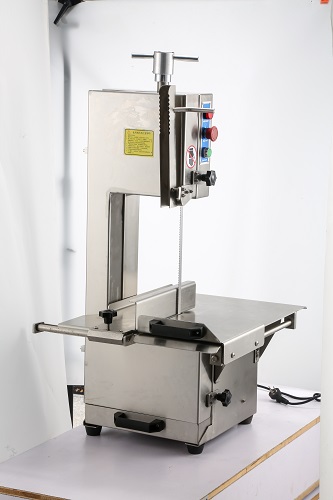Bone saw blades are specially designed tools for cutting bone and are widely used in medical surgery, veterinary operations, and the food processing industry. Bone saw blades are often used for tasks that require precise and efficient cutting of hard materials such as bone and cartilage. They are essential in medical surgery, especially in amputations or surgeries involving bone cutting. They are also used in the food processing industry to handle meat and break down animal carcasses. Depending on the application requirements, bone saw blades are designed to withstand the high-intensity working environment when cutting bone without quickly losing sharpness or durability during the cutting process.
Materials:
Bone saw blades are usually made of materials that provide strength, durability, and wear resistance. Common materials include:
Stainless steel: Stainless steel is widely used due to its excellent corrosion resistance, high strength, and ability to retain sharpness. It is especially suitable for medical environments where hygiene and durability are required.
High carbon steel: High carbon steel blades are common due to their better edge retention and enhanced toughness. However, they are prone to rusting if not properly maintained.
Titanium alloy: Some special bone saw blades are made of titanium alloy. Titanium alloy is lightweight and corrosion-resistant, making it ideal for use in medical equipment where precision and reliability are required.
Ceramic coating: Some bone saw blades use ceramic coatings to enhance the blade's durability, wear resistance, and reduce friction, making them suitable for more demanding applications.

Features:
Bone saw blades have several significant features that set them apart from ordinary cutting blades:
Fine tooth design: Bone saw blades are usually designed with fine teeth, which makes them more efficient when cutting hard bones and soft bones, while reducing friction and heat buildup. The teeth are generally serrated, ensuring smooth cutting and reducing the possibility of bone fragmentation.
Heat treatment: Most bone saw blades are heat treated to increase their hardness and strength. This treatment enhances the blade's wear resistance and is ideal for cutting dense bone materials.
Ergonomic handle: Bone saw blades, especially those used in surgical tools, are usually equipped with ergonomic handles to ensure that the user can maintain precise and stable operation.
Corrosion resistance: Since bone saw blades are often used in wet environments, such as surgery or meat processing, they are generally resistant to rust and corrosion. Selecting materials such as stainless steel can help extend the life of the blade.
Precise Cutting: Bone saw blades are designed to provide clean and precise cuts, which are essential for medical procedures. Clean cuts help reduce the risk of infection during surgery.
Advantages:
Durability: The high-quality materials used in bone saw blades ensure that they are long-lasting and can withstand the high-intensity loads applied during use. Durability reduces the frequency of blade replacement.
Efficient Cutting: Bone saw blades are designed to improve cutting efficiency and can easily cut hard bone materials. The fine tooth shape and sharp edges reduce the force required when cutting, improve work efficiency and reduce user fatigue.
Versatility: Bone saw blades are widely used in multiple industries, such as medical surgery, food processing, and animal care. Whether in veterinary surgery or in the food processing industry, they are a reliable solution for cutting bones and cartilage.
Precision and Cleanliness: Bone saw blades are designed to provide precise and clean cuts, which are particularly important in medical surgery. Clean cuts help avoid complications during surgery and reduce damage to surrounding tissue.
Hygienic Design: Bone saw blades made of corrosion-resistant materials such as stainless steel are hygienic and are particularly suitable for medical environments where keeping the equipment clean is critical.
Application Areas:
Medical Industry: In the medical field, bone saw blades are used to cut bones during surgery, especially when amputations, joint replacements, or spinal surgery are required.
Veterinary Surgery: Bone saw blades are also used in veterinary surgery, similar to human surgery, for amputations, joint surgery, or bone removal in animals.
Food Industry: Bone saw blades are also widely used in the food processing industry for cutting meat and bones. Butchers and meat processing plants use these blades to break down animal carcasses into small pieces for later processing.
Construction and Demolition: Bone saw blades are sometimes also used in some special demolition or construction applications to handle tasks such as cutting bones or dense materials.
Pet Care and Animal Husbandry: In the pet care industry, bone saw blades are used to cut animal bones, especially when preparing food for pets. They help cut bones into smaller pieces that are easier for pets to eat.
FAQ
Rust and Corrosion: High carbon steel bone saw blades are susceptible to rust and corrosion, especially if not cleaned or stored properly. Proper cleaning and storage are key to avoiding this problem.
Dullness and Wear: The sharpness of bone saw blades will gradually decrease with use, especially when they come into contact with hard objects. Regular sharpening is necessary to maintain optimal performance.
Damaged or Broken Teeth: If bone saw blades are used improperly, the teeth may become damaged or broken. This is usually caused by improper operation or use for inappropriate tasks.
Overheating: Bone saw blades may overheat due to excessive heat generated by friction when used for a long time. Overheating can affect the performance of the blade and even cause it to deform or lose its sharpness.
Safety Issues: Because bone saw blades are often used for high-precision cutting tasks, improper use may cause injury. In medical surgery, improper operation may cause patient injury; in the food industry, it may also cause worker injury.




